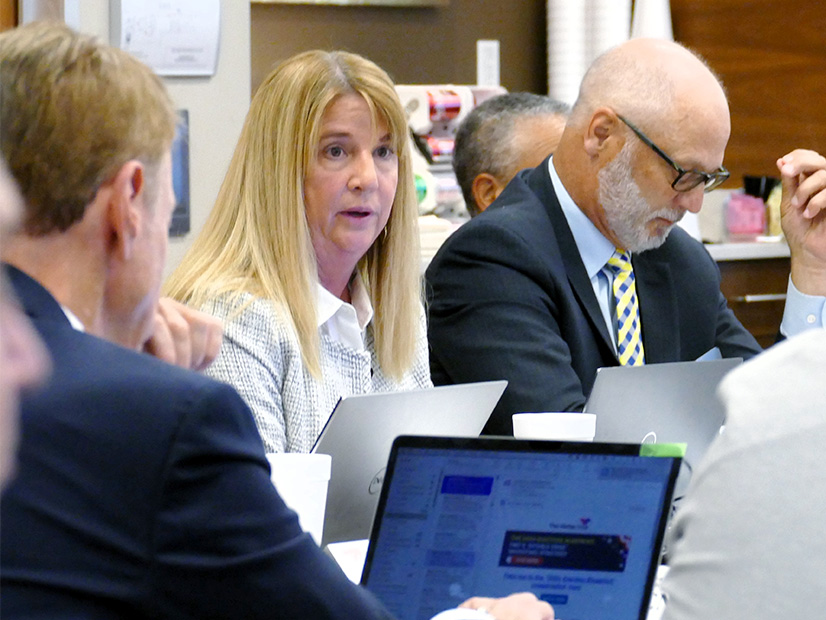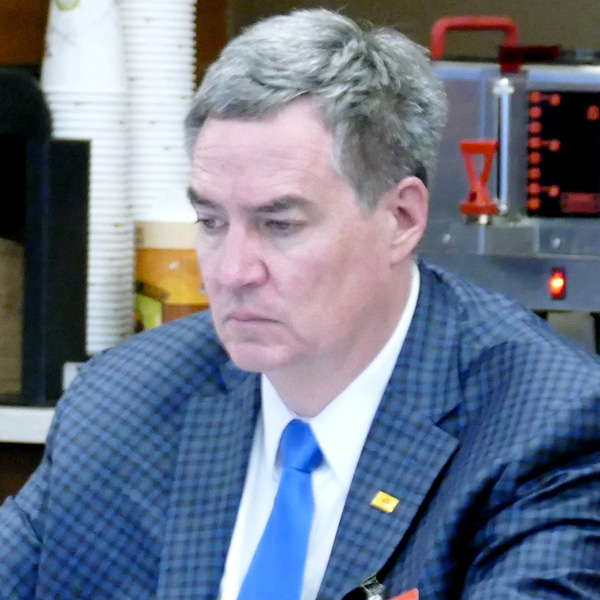
Directors Approve 2025 Budgets, Net Revenue Requirement
LITTLE ROCK, Ark. — SPP’s Board of Directors approved the RTO’s 2025 operating and capital budgets and its net revenue requirement (NRR) on Oct. 29 following a unanimous endorsement by the Members Committee.
The budget includes $296.3 million in expenses, a 7.6% increase ($21 million) from this year’s budget. SPP’s headcount has exceeded 650 to meet an increasing workload, thanks to Western Interconnection market services and FERC orders 881 and 841.
The NRR is budgeted for $204 million, a 6.2% increase from the current $192.1 million. Staffing and related expenses account for about two-thirds of the NRR. SPP’s tariff limits the NRR to a ratio of estimated annual transmission usage, the effective administrative fee. Currently capped at 46.5 cents/MWh, SPP has filed a board-approved increase to 51.5 cents/MWh.
The capital budget was initially set around $35 million, more than doubling the 2024 allocation of $17 million. However, SPP identified projects that could be deferred or eliminated to reduce that spending to $22.1 million.
Independent Director Stuart Solomon, who chairs the Finance Committee, commended staff and the committee for putting together “one of the best budget documents” he has ever seen.
“I think you’ll agree with me that they met the goal of balancing necessary expenses with affordability and member value,” he told stakeholders during the board’s October meeting.
“We started way back in February of this year with a particular goal in mind: to try to bring greater alignment between SPP strategy, our operating plan, the identification of the necessary resources to effectuate that operating plan and, ultimately, the delivery of the budget,” CFO David Kelley said.
Kelley and Solomon both pointed to the NRR’s run rate, or the cost to operate the RTO year to year, as a metric to watch. The NRR’s budgeted run rate next year is a 4.5% increase from 2024.
“I think that’s impressive, given the increasing costs that all of us are experiencing and the amount of new work and requirements that SPP and SPP staff is dealing with,” Solomon said.
Members expressed support for the budget but cautioned SPP about not forgetting who ends up paying for the budget increase.
“We appreciate the additional focus on controlling costs in this particular budget,” Oklahoma Gas & Electric’s Emily Shuart said. “That said, I do want to be transparent about our expectations going forward, and that we don’t find the 4.5% year-over-year increases sustainable or representative of the budget constraints that members like OG&E are facing. This budget is just one cost stream associated with membership that our customers end up bearing.”
“We understand that these are real dollars that we’re asking you all to spend and they show up on ratepayer bills at the end of the day,” Kelley said. “I can assure you that everyone throughout the SPP organization understands that, and we understand that we have to keep costs as low as reasonably possible.”
Dec. 16 Key Date for Markets+
SPP’s Antoine Lucas, vice president of markets, told stakeholders that staff are targeting Dec. 16 to begin building out its Markets+ offering in the Western Interconnection.
The RTO hopes its response to FERC’s deficiency letter will have met with the commission’s approval by then and that it has also executed Phase 2 funding agreements with interested market participants. (See SPP Dispels Concerns over Markets+ Deficiency Letter.)
“With those two things, we have everything that we need to move forward with the actual development of the market and the execution of Phase 2,” Lucas said Oct. 28 during staff’s quarterly stakeholder briefings, alluding to the market’s development and delivery.
He said staff have been working “extensively” with Western stakeholders in developing the market protocols. The Markets+ Participants Executive Committee will vote on the new protocol language during its Nov. 12-13 meeting in Portland, Ore.
SPP has also filed its response to FERC’s deficiency letter for the Western expansion of its RTO. It submitted the tariff in June as it seeks to become the first grid operator with markets in both the Western and Eastern Interconnections. (See FERC Issues Deficiency Letter for SPP’s RTO West Tariff.)
Summer Ops Report
Despite summer weather that extended into October, SPP’s Bruce Rew, senior vice president of operations, said demand was high but did not reach record levels. Demand peaked at 54.39 GW in July, short of 2023’s record peak of 56.18 GW.
SPP registered 18 days with loads over 50 GW, one less than 2023 but the third straight year with double-figure 50-GW days. There were only 11 50-GW days total in 2019-2021.
The RTO issued 24 resource alerts or conservative operations calls this year, down from 40 the year before. It did issue a Level 1 energy emergency alert for two and a half hours on Aug. 26, when elevated temperatures and low wind generation resulted in high net load obligations that reached August 2023 levels. Forced outages approached 9 GW, near all-time highs. (See SPP Issues EEA 1 as Heat Scorches Midwest.)
RSC to Engage on Order 1920
The Regional State Committee agreed during its Oct. 28 meeting to collaborate on a cost-allocation process as part of FERC Order 1920’s requirement for a six-month engagement period with relevant state entities or commissions.
The order requires transmission providers to use a 20-year horizon in planning their long-term regional needs.
SPP’s engagement period began Oct. 28 and will end May 5, when the RSC meets in Omaha, Neb. The grid operator has to make a compliance filing next August.
“The six-month engagement period … is requiring that we offer to provide a forum for negotiation of a cost-allocation methodology and/or the state agreement process,” SPP attorney Tessie Kentner said. “The order does specify that if there is an existing mechanism in place, such as the RSC, that can also be used.”
Outgoing RSC President John Tuma, a member of the Minnesota Public Utilities Commission, said SPP’s willingness to work with the states is why Minnesota joined the committee.
“You have created a culture within SPP [in which] states are equal partners in this effort and working together to accomplish good things within the RTO structure,” Tuma told SPP CEO Barbara Sugg. “Minnesota values that. We saw the value of RTOs to reduce the cost of energy and providing stable regional grid for us, and so that’s why we joined.”
The RSC also elected its officers for 2025:
-
- President: Pat O’Connell, New Mexico Public Regulation Commission
- Vice president: Chuck Hutchison, Nebraska Power Review Board
- Secretary/treasurer: Kim David, Oklahoma Corporation Commission
“I’ve been involved in RSC for a couple years. What I’ve found is it’s always an opportunity for improvement and there’s always a new challenge, or new challenges, every year,” O’Connell said. “I’m looking forward to the challenge. Thanks to all for the trust in me and the situation we’re in now, because it looks to be a very easy job.”
Annual Membership Elections
During SPP’s annual meeting of members, the membership re-elected board Chair John Cupparo and independent Directors Susan Certoma and Ben Trowbridge to three-year board terms that begin in January.
Certoma will be serving her third term, and Cupparo and Trowbridge their second.
The membership also elected eight utility representatives to three-year terms on the 23-person Members Committee, where they will serve as proxies for their sectors:
-
- Investor-owned utility sector: Tim Wilson (Liberty Utilities) and Denise Buffington (Evergy)
- Cooperative sector: Zac Perkins (Tri-County Electric Cooperative) and Mike Wise (Golden Spread Electric Cooperative)
- State agency sector: Robert Pick (Nebraska Public Power District)
- Independent power producer/marketer sector: Kevin Smith (Tenaska Power Services) and Brett White (Pine Gate Renewables)
- Public interest/alternative power sector: Christy Walsh (Natural Resources Defense Council)
Most of those elected are incumbents. Pick and Buffington are new, but Buffington is serving the remainder of former co-worker Kayla Messamore’s term before beginning her own Jan. 1. White is filling the remainder of former member Rob Janssen’s term, which ends after 2025.
The membership also approved a bylaw change brought forward by the Corporate Governance Committee that will revise the selection of Members Committee representatives. With FERC’s approval, sector members will be able to nominate committee representatives, who will then be submitted to the CGC for nomination to the membership.
The CGC said that sectors selecting their representatives on the committee would best represent the interests of each sector and would encourage greater collaboration and engagement between the sectors.
More Time to Cure RAR Obligations
The board approved a revision request (RR632), previously endorsed by the RSC and Markets and Operations Policy Committee, that gives load-responsible entities several more weeks to address deficiencies in meeting their resource adequacy requirement.
LREs would have from March 15 to May 15 (an additional 30 days) to cure summer season deficiencies and from Sept. 15 to Nov. 15 (15 extra days) to resolve winter season deficiencies.
The board’s consent agenda included SPP’s annual violation relaxation limit analysis; converting the Reliability Compliance Advisory Group to a user forum, removing the formal requirements of a chair and recorded minutes; member nominations to the Finance, Strategic Planning and Human Resources committees; and revising the SPC to mirror the sector-based composition of the Members Committee.
It also included another RR (RR649) that aims to add value to the network resource interconnection service (NRIS) product by creating an expedited process for designating new network and designated resources outside of the aggregate transmission service study process. It also revises the generator interconnection study process for new NRIS requests, defines deliverability areas and allows existing resources that meet eligibility requirements to use the expedited process.



